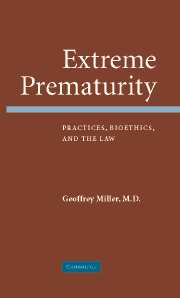Book contents
- Frontmatter
- Contents
- Part 1 THE EXTREMELY PRETERM INFANT: EPIDEMIOLOGY, PERCEPTIONS, AND PRACTICES
- 1 Introduction
- 2 Historical Aspects
- 3 Survival
- 4 Influence of Obstetric Management
- 5 Effect of Resuscitation in the Delivery Room
- 6 National Comparisons
- 7 Prediction of Outcome
- 8 Limit of Viability
- 9 Morbidity
- 10 School Age Outcome
- 11 Adolescence
- 12 Perceptions and Practices
- 13 Resource Expenditure
- Part 2 BIOETHICS
- Part 3 REPORTS, OFFICIAL OPINIONS, AND GUIDELINES
- Part 4 THE LAW
- Part 5 EPILOGUE: TRUTH, TRUST, AND BOUNDARIES
- References
- Index
12 - Perceptions and Practices
Published online by Cambridge University Press: 23 September 2009
- Frontmatter
- Contents
- Part 1 THE EXTREMELY PRETERM INFANT: EPIDEMIOLOGY, PERCEPTIONS, AND PRACTICES
- 1 Introduction
- 2 Historical Aspects
- 3 Survival
- 4 Influence of Obstetric Management
- 5 Effect of Resuscitation in the Delivery Room
- 6 National Comparisons
- 7 Prediction of Outcome
- 8 Limit of Viability
- 9 Morbidity
- 10 School Age Outcome
- 11 Adolescence
- 12 Perceptions and Practices
- 13 Resource Expenditure
- Part 2 BIOETHICS
- Part 3 REPORTS, OFFICIAL OPINIONS, AND GUIDELINES
- Part 4 THE LAW
- Part 5 EPILOGUE: TRUTH, TRUST, AND BOUNDARIES
- References
- Index
Summary
It has been stated that the decisions to forego life-sustaining treatment for an EPTI should be a joint one combining the knowledge of the physician with the wishes of the parents.(130) But the purported decision makers are not homogeneous groups, the knowledge of the physicians is not necessarily reliable or certain in all cases, and the wishes of all parents are also not necessarily realistic or reasonable. There are different times at which a decision to forego life-sustaining treatment could be made. The first is at the time of birth, although obstetric decisions prior to this might affect the perinatal outcome. But at birth, there is often a competent team of doctors and nurses who initiate resuscitation, often perhaps without all the information required for prognosis. Birth weight may be only estimated and gestational age uncertain. Even so, care is not rendered only when absolute success is assured. As Lorenz and Paneth wrote,(131) treatment of the EPTI often falls into one of the three categories. The first is where most would treat. The second is where most would not treat, and a third group exists where there is variability and disagreement. They also noted that the personal characteristics and views of the physicians strongly influence their decision making, and that they may impose their own values on the family. But the situation is one in which there is often uncertainty.
- Type
- Chapter
- Information
- Extreme PrematurityPractices, Bioethics and the Law, pp. 34 - 44Publisher: Cambridge University PressPrint publication year: 2006



